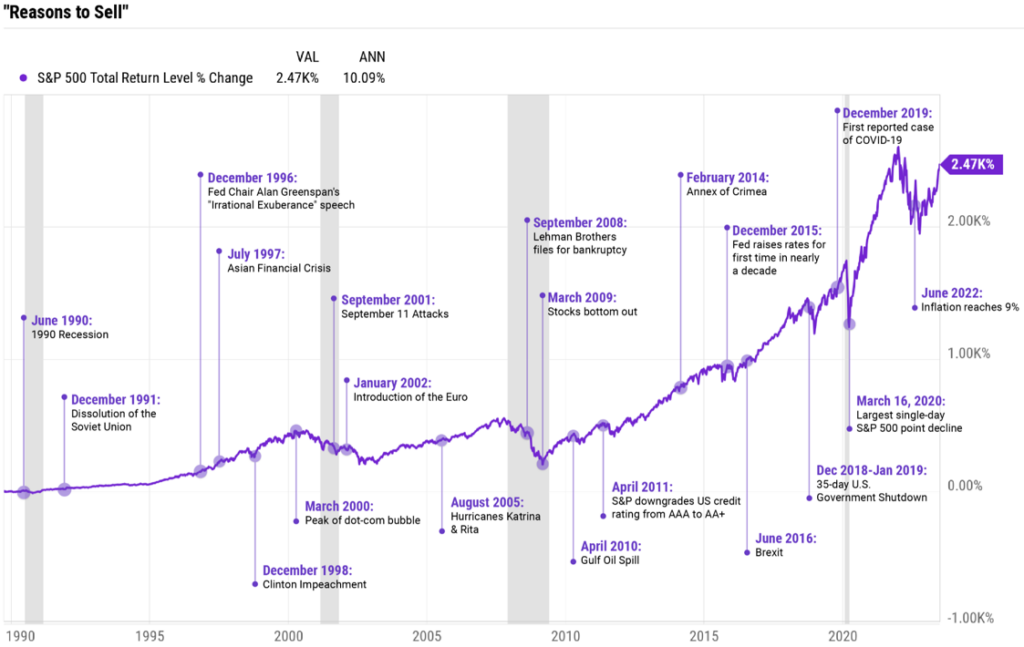
CIO Mailbag: Navigating Market Uncertainties
What advice would you offer individual investors in terms of navigating market uncertainties, building diversified portfolios, and achieving long-term financial goals?
Honestly, the first piece of advice that popped into my head when reading this question was to suggest that individual investors turn off the news and ignore investing-related social media ‘influencers’. I say this somewhat tongue-in-cheek, but it’s helpful advice, at least when it comes to navigating periods of market volatility.
Let your advisor and their team worry about deciphering what is a market signal and what is ‘noise’. I’ve learned over the years that things are never quite as good, or as bad, as they may seem in the moment. 99% of what you see and hear on the news or on social media is simply ‘noise’ designed to evoke emotion. Most of us understand this at an intuitive level, but it’s still hard not to be affected by the constant bombardment of pessimistic messaging. In fact, during times of significant market volatility, news headlines and social media content can be downright unnerving. If I acted upon every fearful impulse generated by this content, we’d have client portfolios comprised entirely of cash stuffed under a mattress held in a bunker somewhere in Idaho.
While a little bit dated, a chart like the one below helps to illustrate this point. Theoretically, there is always going to be a reason to sell-out of your portfolio and sit on the sidelines in cash. This particular chart highlights a few key inflection points, yet there could easily be weekly bullet points due to the perpetual and pessimistic news cycle.

Source: YCharts
In 2023 alone, investors navigated a banking crisis, war between Israel and Hamas, a debt ceiling standoff, a credit rating downgrade of U.S. debt, additional Fed rate hikes, and more, yet, markets ascended higher.
Not-so-fun fact: did you know that over the past 44 years, the average intra-year decline in the S&P 500 index has been -14.2%. This means that investors should expect the stock market to decline roughly -14% at some point every year. Is this trend linear? No. Are some years more volatile than others? Of course, and this is why investors can get somewhat complacent about risk during bull markets.
Regardless, during times of volatility, it’s important to remember that we are long-term investors. It’s also crucial for investors to appropriately diversify their investment holdings based on their personal tolerance for risk and their stated financial goals. As the late Charlie Munger would say, the first rule of compounding is to never interrupt it unnecessarily. This means that an investor needs to remain fully invested over the long-term, but that can often be easier said than done.
As a brief aside on diversification, each weekend at home, I bake two loaves of whole wheat bread that I use for breakfast and lunch for my family throughout the week. I have to say, with all appropriate modesty, that my whole wheat bread is the best I’ve ever tasted. However, it took quite a bit of time, testing and research to perfect my recipe. Yes, most bread is comprised of flour, yeast, salt, water and, depending on the type of bread, perhaps a few other ingredients like egg, oil, honey, milk and so forth. However, the outcome can be vastly different if those ingredients are mixed in the wrong proportions, or proofed and baked at the wrong time and temperature. Over months and months of testing, I finally developed what I would consider an ‘optimized’ bread recipe with the right balance of ingredients to provide the best, and most consistent, results.
This is not entirely different from portfolio construction. Asset classes are like ingredients. When building client portfolios, we attempt to assemble an optimized mix of asset classes that will produce superior risk-adjusted returns in a variety of market environments. This portfolio allocation is inextricably tied to a client’s tolerance for investment risk. Can an investor stomach watching a $1,000,000 portfolio potentially decline -$142,000 in value in any given year? Remember, the average intra-year decline for the S&P 500 is -14.2%. If the answer is yes, then perhaps the portfolio can be geared towards more aggressive asset classes. If the answer is no, then there needs to be better balance built into the portfolio to mute volatility during times of market uncertainty.
Remember, the ultimate goal is to not interrupt compounding unnecessarily, and this only happens if an investor’s portfolio is diversified in a way that will allow them to sleep at night without feeling the need to pile cash under the mattress. Unfortunately, unlike a bread recipe, an investor can’t afford a trial-and-error strategy with their nest egg. One mistake – such as liquidating assets during a selloff – can have significant consequences for personal financial goals.
This is why working with an advisor can be crucial. An advisor can help an investor understand their tolerance for investment risk, outline their personal and financial goals, then have a portfolio constructed that is in alignment with their risk tolerance and goals.
When it comes to navigating times of market uncertainty, I would encourage you to give yourself permission to outsource your stress and angst to your financial advisor and let them, and their team, carry the burden and duty of being the steward for your investments. I assure you, it’s a burden that we are well-equipped to bear, and a duty that we carry out with pride.
Important note and disclosure: This article is intended to be informational in nature; it should not be used as the basis for investment decisions. You should seek the advice of an investment professional who understands your particular situation before making any decisions. Investments are subject to risks, including loss of principal. Past returns are not indicative of future results. Advisory services provided by Destiny Capital Corporation, a registered investment adviser.
2024 YCharts, Inc. All Rights Reserved. YCharts, Inc. (“YCharts’) is not registered with the U.S. Securities and Exchange Commission (or with the securities regulatory authority or body of any state or any other jurisdiction) as an investment adviser, broker-dealer or in any other capacity, and does not purport to provide investment advice or make investment recommendations. This report has been generated using data manually input by the creator of this report combined with data and calculations from YCharts.com and is intended solely to assist you or your investment or other adviser(s) in conducting investment research. You should not construe this report as an offer to buy or sell, as a solicitation of an offer to buy or see, or as a recommendation to buy, sell, hold or trade, any security or other financial instrument. THE IMPORTANT DISCLOSURES FOUND AT THE END OF THIS REPORT (WHICH INCLUDE DEFINITIONS OF CERTAIN TERMS USED IN THIS REPORT) ARE AN INTEGRAL PART OF THIS REPORT AND MUST BE READ IN CONJUNCTION WITH YOUR REVIEW OF THIS REPORT. Disclosure – YCharts




